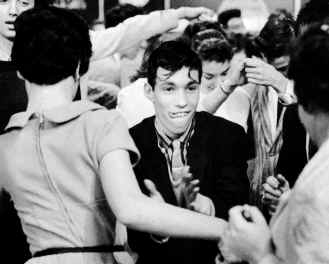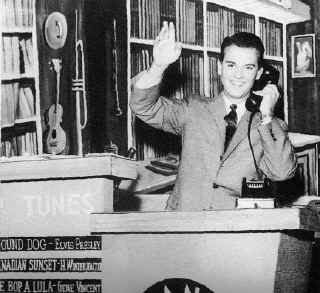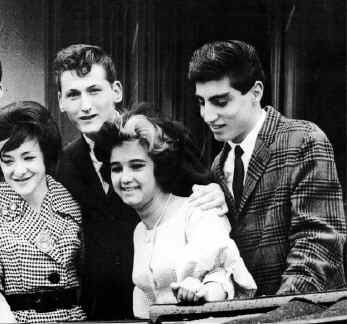
Advertising
on American Bandstand

With a college degree in advertising and an uncanny ability to speak to teenagers, Dick Clark was the perfect pitchman for sponsors whose products - from shampoo to acne medication to watches - were targeted at the adolescent market. In the late fifties, as the teenage market expanded and the number of teenagers jumped from seven million to twelve million, Clark shifted from local spokesman for Barr's, a popular Philadelphia jewelry store, to a national spokesperson doing endorsements for hair tonic, chewing gum and soda. He helped link up enough sponsors to make American Bandstand one television's most profitable daytime shows

When the kids on American Bandstand were not Strolling, or Twisting, or Chalypsoing, they were usually Jitterbugging. The Jitterbug was a Philadelphia staple, and there were many variations as there were Philadelphia neighborhoods. The dance began in the 1920s in the bars of Harlem and took the steps from the Shag and the Charleston. Although dancers did wild improvisational solos as part of the Jitterbug, it was essentially a partner dance. In 1927, the solos gave rise to a new variation, the Lindy Hop, named after Charles Lindbergh, who had just made his historic solo flight across the Atlantic. The Jitterbug gained wide popularity in the thirties when Swing was at its peak. During WW II, U.S. soldiers took the dance around the world and it was recognized as quintessentially American
One way to spotlight the songs, the dancers, and the dances on American Bandstand was to hold dance contests. Kids in the studio loved them, and the viewers did, too. The rules were simple. Contestants had to sign up to get a number, then once a week they pinned numbers on their backs, much like they did in the dance marathons in the thirties. During the contests, viewers cast ballots for their favorite dancers. Each contest lasted three or four weeks, after which winners were announced on the air. Several of the winners confessed that the voting was done more on popularity merit. Still, they took their prizes, which ranged from portable TVs to juke boxes.

As audiences for Bandstand grew, so did the stakes for the dance contest winners, who took hom prizes that ranged from record albums to brand new cars. Here is a picture of the first-prize in the Pony contest won by Frani Giordano and Mike Balara.

Dick Clark inherited the original set for American Bandstand from Bob Horn's Bandstand, the show Clark took over in 1956. The painted background was that of a record shop of the late forties or early fifties, when records were big, clunky 78 RPMs. Clark's high podium, like a bandstand, set him apart from the dancers. The podium was donated to the Smithsonian Institute in 1981.
"Joanne seventeen South Philly," "Mark J, fourteen Bartram,' "Scott fifteen, North Catholic." Roll Call was a regular feature on American Bandstand and how the viewers at home got to know the kids on the show. When the show was only broadcast locally the kids gave the names of their schools, as well as names and ages. When the show went national in 1957, they gave their names, ages and their hometown.
Kids watching Bandstand at home were looking for any clues that signaled romance between kids on the show - who danced with whom, how closely they danced, and how slow they danced together. In the innocent fifties euphemisms for touching and sex abounded in the American culture, especially in television. Harmless games - where kids came into more innocent contact with each other - spiced up the Bandstand program. In this awkward moment, teens cooperated to eat up the string attached to a marshmallow. Of course, if both partners succeeded they came as close to kissing each other as was possible on a show that morally towed the line.
Jayce,
Norman,Carmen, Frank

(L-R) Jayce Schaeffler, Norman Karr, Carmen Jimeniz, Frank Vacca
Dick Clark's unique talent was taking the music that America was afraid of - rock 'n' Roll - and broadcasting it while introducing it to adults that hated it. Well dressed and well behaved, Clark and kids on American Bandstand were instrumental in populaizing a new kind of music that was under attack by everyone from Frank Sinatra, ' the most brutal, ugly, desperate, vicious form of expression, it has been my misfortune to hear; to Sammy Davis Jr. "If rock 'n' roll is here to stay, I might commit suicide; to author Vance OPackard, Rock music might be best summed up up as a montony tinged with hysteria;" to Tip O'Neil, then the Speaker of the House, who said in 1960, "rock and roll is the type of senuous music unfit for impressionable minds."
One of the hazards of dancing on American Bandstand was the miles of thick black cable that wove itself around the dance floor for the huge TV cameras that dominated the dance floor. A white line separated the cameras from the dancers, but the line was constantly violated as the camera searched for better pictures of the dancing kids. Often teens had to stop dancing to step over the cable, an awkwardness rarely seen by the viewers at home.
October 27, 1959, was Brenda Lee Day On American Bandstand. The 4' 11' dynamo had been performing since she was a toddler, by the age of six had her own fifteen minute television sho and by twelve several regional country hit songs, including Dynamite, the song that her her nickname Little Miss Dynamite. In 1958 she recorded on of the best rock 'n' roll Christmas songs ever, Rockin' Around the Christmas Tree, which wasn't released until 1960, when it went to the top of the charts. I'm Sorry, Sweet Nothin's and I Want To Be wanted were in the Top Ten the next year. In 1962, when she was eighteen, she made Break It To Me Gently, a ballad whose emotional message would have been difficult for a singer twice her age.